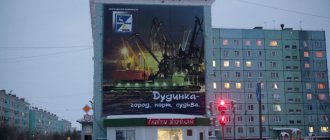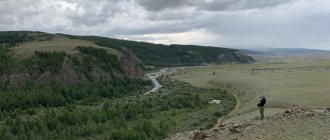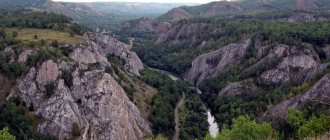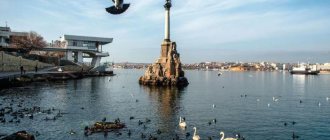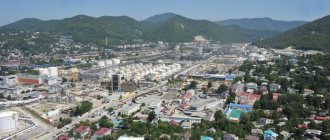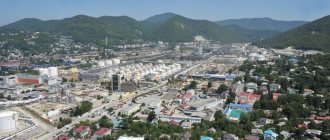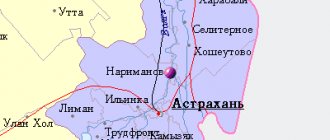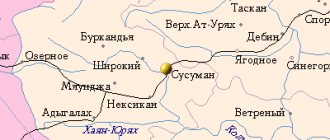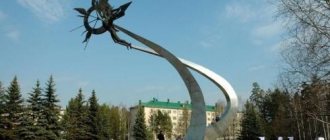Baikal ice is very similar to mica
Listvyanka and Slyudyanka are twin brothers. Both settlements are located on the shores of Lake Baikal near Irkutsk and are popular holiday destinations. People also come to Slyudyanka to conquer the Khamar-Daban mountain range and see the unique collection of minerals in the local museum.
Mineralogical paradise
The name Slyudyanka speaks for itself. In these places, mica was mined 300 years ago! Then this transparent mineral replaced glass in windows. At the mining site they set up a winter hut, which they called Slyudyanka. Since then, the settlement has changed its status several times - it was a fort, a village, a city - but the name remained the same each time. This is a real mineralogical paradise - in addition to mica, lapis lazuli and marble were mined here.
The town with the “mineralogical” name is located on the western shore of Lake Baikal and administratively belongs to the Irkutsk region. The population exceeds 18 thousand people. The city has a railway station through which the famous Trans-Siberian Railway passes. Slyudyanka is also a transit point on the R-258 Baikal highway.
Fish is the main wealth of Baikal
People have inhabited these regions since ancient times. This is evidenced by rock paintings found by archaeologists at Cape Shaman. The Huns, Kurykans, Buryats, and Evenks lived on these lands. Russians came here in the 17th century. These were pioneers who were looking for opportunities to mine salt and furs. In 1647, the first fort appeared here - that’s what small fortresses were called. In 1802, a winter hut was built on the shore of the lake and mica mining began.
An important factor for the development of the settlement was the construction of a wheeled road. Thanks to this, Slyudyanka turned into a postal station and goods transshipment point between Irkutsk and Kyakhta. The construction of the railway gave even greater impetus. In this regard, in 1899, the Slyudyanka winter hut received the status of a village. This year began to be considered the date of its foundation. Now the village is a popular place for recreation and tourism.
HOW TO GET THERE
You can get to Slyudyanka from Irkutsk by your own car along the Kultuksky highway (M55 highway), the distance from Irkutsk to Slyudyanka is 115 km and can be covered in 1.5-2 hours.
By bus (Irkutsk - Slyudyanka):
A regular bus runs from Irkutsk to Slyudyanka from the suburban bus station every hour. The bus station telephone numbers are information and ticket offices, the ticket price is 100 rubles, the route schedule is here.
You can also get to Slyudyanka by minibus from the Irkutsk railway station (Chelnokova St., 1; reference phone 8-902-767-8618). Travel time is 1.5 - 2 hours.
By train (Irkutsk - Slyudyanka):
Every day you can get from Irkutsk to Slyudyanka by train (several flights a day, schedule here). Travel time is about 3 hours.
Note to tourists
The main asset of Slyudyanka is the Khamar-Daban mountain range. A huge mountainous country stretches south of Lake Baikal. Its length is 350 kilometers, width is 60 kilometers. The highest peak is Mount Utulikskaya Podkova (2396 m). It is Khamar-Daban that is a point of attraction for climbers, skiers and lovers of extreme hikes. Every year a ski marathon is organized here, which is called the “Baikal Around the World”.
Khamar-Daban mountain range
The second key natural attraction is Shamansky Cape. For the Buryats this place is sacred. The Circum-Baikal Railway is a monument of engineering art. This is also an excursion site. The mineralogical museum “Gems of Baikal” is interesting. His collection numbers about 12 thousand exhibits!
Listvyanka has an excellent mineralogical museum
There is a local history museum in the city. Historical architectural monuments include the railway station and St. Nicholas Church. But Baikal is rightfully considered the main attraction. People come from all over the world to see it. There are more than a dozen hotels, guest houses and recreation centers in the city and its surroundings. There is enough space for everyone.
Neighborhoods of Slyudyanka
Shamansky Cape is located near present-day Kultuk, about 10 km from the Slyudyanka-I station. Both locals and tourists come here with pleasure: at the end of the cape there is the “Terrible Stone”, an elongated island connected to the cape by a narrow isthmus. This is a sacred place for the Buryats, where rituals and sacrifices were held in ancient times.
Khamar-Daban
West of Slyudyanka, partly on the territory of Buryatia, is located Khamar-Daban. This is a unique mountainous country with stunning landscapes and wildlife. In the center of Khamar-Daban is the Baikal Biosphere Reserve, to the west is the Snezhinsky Nature Reserve, and even further west is the Tunkinsky National Park. Travelers will find all the opportunities for water tourism here, including large rivers, picturesque lakes, and mountain peaks suitable for climbing.
Numerous popular tourist routes along Khamar-Daban begin in Slyudyanka. All of them are quite long and involve at least one overnight stay. For example, the well-known hiking trail leading to Chersky Peak involves 25 km of walking in one direction, past the famous Heart Lake.
Chersky Peak is the highest peak of Khamar-Daban (2090 m). Conquering this height is not so difficult: no mountaineering skills or equipment are required. Therefore, the peak is very popular among tourists from all over the country, and in September all-Russian competitions in speed climbing to the top are held here.
Church of St. Nicholas the Wonderworker
A beautiful temple near the railway station was erected in 1915, but almost 15 years later it was closed. Only towards the end of the war, in 1947, was it returned for the needs of the residents.
The inside is very clean and bright, with interesting architecture, because the object is a cultural monument of regional significance. Moreover, it is considered one of the most prayed for due to its long history.
Location: 40 Let Oktyabrya Street - 40.
Steam locomotive Lebedyanka
This facility is located near the Water Tower. The steam locomotive, together with the tower, is a kind of “reconstruction” of a water filling station. A great place for a photo shoot or an evening stroll, the monument is in excellent condition and is constantly being repainted.
A very interesting place for children who like technology. The monument fits perfectly with the surrounding infrastructure and will become an interesting object to visit when traveling to Slyudyanka.
Location: Paris Commune Street - 1A.
About the climate
Climatic conditions in the city of Slyudyanka are characterized as moderate continental. This is primarily due to the close proximity of Lake Baikal. Winter here is much milder than in the Irkutsk region. Spring is protracted and long, in summer the maximum temperature is observed in August, autumn lasts a long time...
The town itself is located in a natural basin, surrounded on almost all sides by mountain ranges and Lake Baikal. Because of this, there is little rainfall here. Mountain winds blow very often.
Monument to the Bear and Monkey
A small monument at the exit from the city shows the viewer the main characters of I. A. Krylov’s fable - a bear and a monkey. They are located at a distance from each other, the monkey is twirling a shiny mirror in its paws. The object is made of white marble and is intended to serve as a reminder for passing drivers.
The characters are recognizable and funny, and this monument is ideal for a photo souvenir. Moreover, it is located literally on the outskirts of the city of Slyudyanka.
Location: Lenin street - 119.
Train Station
The station building is the only building in all of Russia entirely built of marble. It looks great: silver arches, huge windows and a dark blue sign with the name of the station. The inside is clean and modern, with an interesting exhibition about the history of the station. You can see photographs of this place from different years.
It is known that the building itself was erected by Italians. On the territory of the station there is a small souvenir shop for city guests.
Location: Tonkonoga street - 18.
Links[edit]
Notes[edit]
- ^ a b Charter of the Irkutsk region
- ^ ab Register of administrative-territorial entities of the Irkutsk region
- ^ a b Federal State Statistics Service (2011). All-Russian Population Census 2010. Volume 1 [All-Russian Population Census 2010, vol. 1]. All-Russian Population Census 2010 [All-Russian Population Census 2010] (in Russian). Federal State Statistics Service.
- "26. The size of the permanent population of the Russian Federation by municipalities as of January 1, 2022". Federal State Statistics Service. Retrieved January 23, 2022.
- ^ ab Law No. 49-OZ
- ^ abcde Law No. 72-ounce
- "On the Calculation of Time". Official Internet portal of legal information
. June 3, 2011. Retrieved January 19, 2022. - Post office. Information and computing center of OASU RPO. ( Post office
).
Search for postal service objects ( postal Search for objects
) (in Russian) - ↑
Federal State Statistics Service of Russia (May 21, 2004). The population of the Russian Federation as part of federal districts, urban settlements, settlements, settlements, settlements, settlements, settlements, settlements, settlements, settlements, settlements settlements, settlements, settlements, settlements.[Population of Russia, its federal districts, constituent entities of the Federation, districts, urban settlements, rural settlements - administrative centers and rural settlements with a population of more than 3000 people] (XLS). All-Russian Population Census of 2002 [All-Russian Population Census of 2002] (in Russian). - All-Union Population Census of 1989 Population of Union and Autonomous Republics, Autonomous Regions and Districts, Territories, Regions, Urban Settlements and Village District Centers [All-Union Population Census of 1989: Current Population of Union and Autonomous Republics, Autonomous Regions and Districts, Territories, Regions , districts, urban settlements and villages performing the functions of district administrative centers]. All-Union Population Census of 1989 [All-Union Population Census of 1989] (in Russian). Institute of Demography of the National Research University: Higher School of Economics [Institute of Demography of the National Research University: Higher School of Economics]. 1989 - via Demoscope Weekly
.
Sources [edit]
- Legislative Assembly of the Irkutsk Region. Resolution No. 9 / 5-ЗС dated April 15, 2009 “Charter of the Irkutsk Region”, as amended. Law No. 2-U of December 14, 2022 “On amendments to the Charter of the Irkutsk Region.” Came into force ten days after official publication. Published: “Regional”, No. 45, April 24, 2009 (Legislative Assembly of the Irkutsk Region. Resolution No. 9/5-ZS of April 15, 2009. Charter of the Irkutsk Region
as amended by Law No. 2-U of December 14, 2022 "
On introducing amendments to the Charter of the Irkutsk Region
on the day following the ten-day period after the day of official publication.). - Legislative Assembly of the Irkutsk Region. Law No. 49-OZ of June 21, 2010 “On the administrative-territorial structure of the Irkutsk region,” as amended. Law No. 12-OZ of March 23, 2022 “On Amendments to Articles 25 and 33 of the Law of the Irkutsk Region “On the Administrative-Territorial Structure of the Irkutsk Region” and the Law of the Irkutsk Region “On Amendments to a Geographical Object and (or) on the Renaming of Geographical Objects " Came into force after the official date of publication. Published: “Regional”, No. 71, June 25, 2010 (Legislative Assembly of the Irkutsk Region. Law of June 21, 2010 No. 49-OZ “ On the administrative-territorial structure of the Irkutsk Region”
, As amended by the Law of March 23, 2022 No. 12-OZ.
On amendments to Articles 25 and 33 of the Law of the Irkutsk Region “On the Administrative-Territorial Structure of the Irkutsk Region” and the Law of the Irkutsk Region “On the Procedure for Considering the Assignment of Names to Geographical Objects and (or) Renaming of Geographical Objects". "
. Effective with day of official publication). - Legislative Assembly of the Irkutsk Region. Law No. 72-oz of December 2, 2004 “On the status and boundaries of municipalities of the Slyudyansky district of the Irkutsk region,” as amended. Law No. 11-OZ of January 14, 2014 “On the transformation of the working village of Baikal (port) of the Slyudyansky district of the Irkutsk region, the extension of the Law “On the status and boundaries of municipalities of the Slyudyansky district of the Irkutsk region” to the entire territory of the new subject of the Russian Federation - the Irkutsk region and making changes to it." Came into force on December 31, 2004, but not earlier than 10 days from the official date of publication. Published: “East Siberian Truth”, No. 248–249, December 14, 2004 (Legislative Assembly of the Irkutsk Region. Law No. 72-oz of December 2, 2004. On the status and boundaries of municipalities of the Slyudyansky district of the Irkutsk region
as amended by the Law of January 14, 2014 No. 11-OZ “
On the transformation of the working village of Baikal (port) of the Slyudyansky district of the Irkutsk region on the expansion of the territory.” The scope of the Law of the Irkutsk region “On the status and boundaries of municipalities of the Slyudyansky district of the Irkutsk region” covers the entire territory of the new subject of the Russian Federation Federation - Irkutsk Region and on amendments to it
... Valid from December 31, 2004, but not earlier than 10 days after the official date of publication.). - Register of administrative-territorial entities of the Irkutsk region
(in Russian)
Water tower
The tower was built thanks to the efforts of captured Poles. Having examined the tower more closely, you can see the message they left during construction. This building was made in the Gothic style, which was unpopular at the time of construction, entirely made of red brick.
The tower is located almost in the very center of the city, not far from the Steam Locomotive and the park. Unfortunately, at the moment the building is in disrepair, and nature has managed to stretch several small bushes of wild herbs through its roof. Nevertheless, the authenticity of the structure gives it a slight charm.
Location: Paris Commune Street - 1A.

